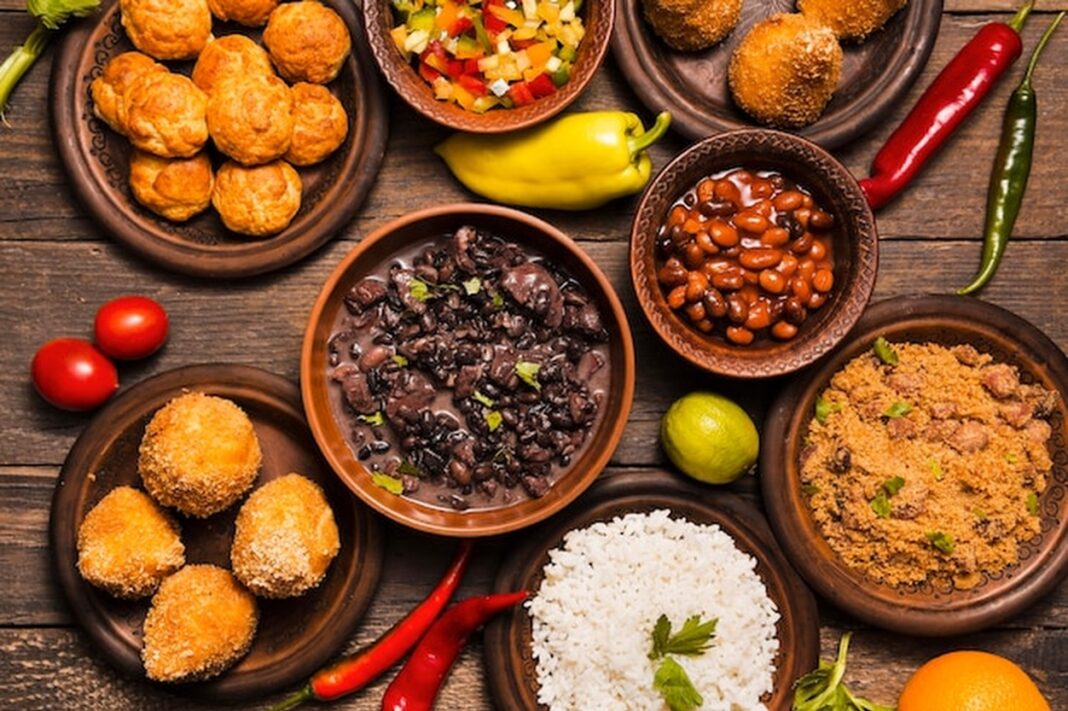Brazil has lively cultures and distinct cuisines. History and geography influence the country cuisine. Indigenous Portuguese and African cultures influence it. This rich blend gives a distinct taste. Every area has its unique cuisine. Exploring Brazilian food involves tastes methods and ingredients. Every meal is authentic and brings people together.
Exploring The Rich Tapestry Of Brazilian Cuisine
Brazilian food is a multicultural tapestry. Every location has its unique spices methods and tastes. Cassava and shrimp are popular in the north. The Amazonian influence offers distinct tastes and textures. Northeastern recipes include robust spices like dend oil and coconut milk. Africa is evident in this food. Southern cuisine emphasizes steak and wine. Regional variances provide a diversified cuisine. At Brazilian restaurants one may taste this type. Street vendors provide tasty fast cuisine. Fine dining restaurants make traditional recipes art.
A Regional Breakdown Of Brazil Culinary Highlights
Due to its large topography Brazil has several gastronomic delights. A delicious tapioca soup called tacac is found in the Amazon. The southeastern area especially So Paulo is noted for its Italian influences. Local ingredients are used in pizza and pasta. Rio Grande do Sul is famed for churrasco grilling. This approach enhances the rich taste of open flamed meat. You must taste acaraj in the northeast. Black eyed pea balls stuffed with shrimp are deep fried. Each region celebrates local resources history and customs with meals.
From Street Food to Fine Dining The Best Places to Eat
Brazil is foodie heaven. Street food vendors provide tasty inexpensive cuisine. Pastis and coxinhas dough stuffed with shredded chicken are sold. These bites are portable. Fine dining establishments are available throughout Brazil. Chefs frequently modernize classic meals. Cities like Rio de Janeiro and So Paulo have Michelin starred restaurants. Gastronomy excels here. Meals are events using seasonal foods. Food events draw international foodies. They highlight regional food and chefs.
The Secrets Behind Brazil Culinary Traditions
Brazilian cuisine is rich in history. Indigenous and African cultures shaped many foods. Manioc and corn are versatile mainstays. Slow cooking and grilling have been handed down for centuries. Culturally significant meals are typically served during celebrations. Traditional cuisines are used during Festa Junina feasts. Brazilian identity may be understood via these culinary customs. The stories of each meal bind individuals to their ancestry and community.
Brazilian Ingredients You Should Know
Brazilian cuisine relies on unusual ingredients. Yucca or manioc is a staple. Boil fry or flour this versatile root. Another crucial ingredient is aa a fruit known for its health benefits. Blended into pleasant smoothies or bowls. Many Bahian meals need dend oil richness. Papaya and guava provide sweetness to dishes. Chefs experiment with these elements in modern meals. Understanding these elements enhances Brazilian food.
Feasting Through Brazil Festivals And Food Fairs
Food is fundamental to Brazil vibrant celebrations. Street sellers provide traditional food and beverages during Carnival. The Festa Junina honours rural customs with substantial food. The group consumes corn based pamonha and sweets. Cities provide food festivals featuring local delicacies. These fairs showcase street chefs and home cooks. Taste different foods to enhance the social experience. Events like these build memories not just meals.
Decoding Brazilian Flavors Spices And Herbs
Brazilian food is full of flavour and robust ingredients. Spices and herbs shine in delicious recipes. Garlic onions cilantro and chilli peppers are common. These ingredients generate rich tasty tastes. Many Brazilian cuisines include garlic to enhance meat and vegetarian foods.
Portuguese control coriander and lime are used in salsas and ceviches. Many dishes benefit from this herb brightness. Additionally Brazilian food embraces chili pepper spiciness. Stews and grilled meats benefit from these mild to spicy peppers. Regional versions include native spices and herbs.
Northerners utilize palm oil and malagueta peppers to make distinctive recipes. Passion for tropical fruits like mango pineapple and coconut improves pastries and beverages. For caipirinhas sugarcane spirit cachaa is mixed with fresh lime and sugar. This popular drink embodies Brazil warmth and celebration.
Dining Etiquette In Brazil What You Should Know
Brazilian dining is lively. Any dinner may be better with local etiquette. Brazilians are very welcoming. Meeting someone usually involves a cheek kiss. Arriving late is okay as punctuality may not be rigorously maintained.
When dining wait for the host to start before eating. Food sharing is frequent among friends and family. Family gatherings frequently include a variety of family style foods. Socializing over meals builds relationships.
Utensils must be used properly. Forks go in the left hand knives in the right. Unlike other meal rituals Brazilians seldom exchange hands. Finishing your meal is courteous too. Wasteful to leave food.
Toasting is popular during meals. A simple Sade wishes everyone good health and happiness. Brazilians savour their meals and conversations. Desserts usually end the meal. Bananas coconuts and dulce de leche are popular.
Where can I find the best Feijoada in Brazil
Brazil loves feijoada and there are many venues to eat it. Best versions are served in tavernas eateries. Feijoada is popular in Rio particularly on Wednesdays and Saturdays. This substantial black bean stew with pig chops is popular among locals. Following the crowds or locals might help you find real restaurants. Popular Ipanema locations include Orosco and Casa da Feijoada. Many restaurants provide live music to make feijoada a cultural experience.
What Makes Brazilian Street Food Unique
Its diversity and robust tastes make Brazilian street cuisine stand out. Diverse cultures shape street life. Crispy and flavorful pastis with diverse fillings are ideal snacks. Pamonha a leaf wrapped sweet corn delight and kibe a Middle Eastern inspired meatball with distinct flavours are also popular. Street food eaten in groups symbolizes the country society. It draws people together during markets and festivals. Affordable prices make these tasty selections accessible to anyone. Tastes communicate stories and depict a dynamic culinary environment.




